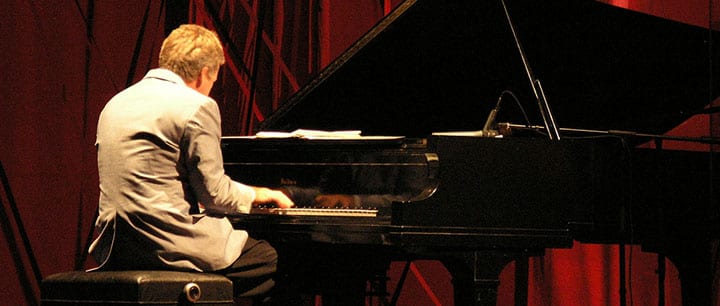 Being a piano player may seem like a very solitary way to go about learning an instrument. As a piano student, you may yearn to make music with others, and if you’re naturally drawn toward group music making, it may be that you already study an orchestral instrument, or sing with a choir. You may also have extended your piano training to accompany some of your friends for concerts or exams, or explored the wide variety of chamber music repertoire available involving the piano. However, had you considered the sheer quantity of orchestral music that requires a piano, aside from the obvious concerto repertoire?
Being a piano player may seem like a very solitary way to go about learning an instrument. As a piano student, you may yearn to make music with others, and if you’re naturally drawn toward group music making, it may be that you already study an orchestral instrument, or sing with a choir. You may also have extended your piano training to accompany some of your friends for concerts or exams, or explored the wide variety of chamber music repertoire available involving the piano. However, had you considered the sheer quantity of orchestral music that requires a piano, aside from the obvious concerto repertoire?
Orchestral Works with Piano
Your piano training to date has no doubt included not just standard scales and finger exercises, but solo piano repertoire as well, ranging from stand-alone pieces to complete sonatas. For more advanced students, your teacher may have introduced transcriptions of famous symphonic works for you to play together as duet material. However, many late romantic and twentieth century orchestral works employ the piano as an instrument in its own right.
A famous example is the last movement of Saint-Saens Symphony No. 3 (also known as the “Organ Symphony”), where the piano adds color to the string statement of the main motif. In the clip below, you can clearly see the positioning of the piano in the orchestra.
It’s important to familiarize yourself with other orchestral keyboard instruments, too; celeste parts are very common, for example. Many Prokofiev symphonies have a prominent piano part, and the increasingly popular symphonies of Bohuslav Martinu all require an orchestral pianist.
Operatic Works with Piano
The life of the orchestral pianist isn’t limited to the concert platform; many operatic works incorporate a piano into the pit orchestra, or even require a pianist to be onstage as part of the action – an excellent opportunity for the more outgoing performer, but not so much fun for the player used to hiding behind the keyboard. Britten’s village comedy Albert Herring requires a pianist for the recitatives, and Ariadne auf Naxos (Richard Strauss) and Dialogues des Carmelites (Francis Poulenc) make use of the piano not just for orchestral color, but as an important instrument on its own. Celeste, harpsichord, and even glass harmonica parts are very common, and all demand an experienced and accomplished orchestral keyboard player.
What to Study to Become an Orchestral Pianist
The skills you need to become an orchestral pianist are slightly different from those you’ll need to play as a solo pianist, or even to accompany one or two musicians or take part in chamber music. If a career as an orchestral pianist and keyboard player interests you, your piano training will need to incorporate some very specific disciplines.
You will need to be able to:
The Life of an Orchestral Pianist
Although the life of the orchestral pianist isn’t quite as lonely as that of the soloist can be, you will still find yourself with a lot more time off than your colleagues, and you may not feel that you are “part of things” in the same way the string or woodwind players are. As with all musical disciplines and career paths, it’s important to build interests and relationships outside of work. Many musicians find that an active teaching practice, for example, helps them to refocus.
Music isn’t always easy or necessarily financially rewarding – however, that’s not why we do it! Have fun exploring the different avenue of piano training, and see what interests you the most!
Photo by ldhendrix
Suzy S.

